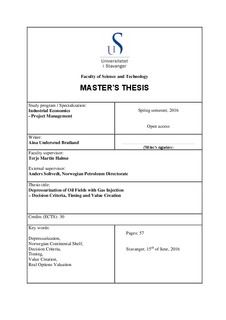| dc.contributor.author | Bratland, Aina | |
| dc.date.accessioned | 2016-10-03T07:41:28Z | |
| dc.date.available | 2016-10-03T07:41:28Z | |
| dc.date.issued | 2016-06 | |
| dc.identifier.uri | http://hdl.handle.net/11250/2412379 | |
| dc.description | Master's thesis in Industrial economics | nb_NO |
| dc.description.abstract | The common approach for oil fields with gas injection is to continue oil production and re-inject the gas produced for as long as it is profitable, and then shift to gas production. However, the value of the gas as well as the option value of gas sales versus injection is important to consider. Stopping gas injection or withdrawal of large volumes of oil/gas will for instance result in a rapid pressure loss, which benefits a shift from oil to gas production. This depressurization process is often referred to as “blowdown” (BD).
The analysis conducted is divided into a qualitative and quantitative part. The qualitative analysis is based on interviews with Statoil focusing on reservoir properties, Increased Oil Recovery (IOR), technical challenges, gas export possibilities and decision criteria concerning BD for both the Statfjord and Oseberg field. As part of the quantitative analysis, a Real Options (RO) valuation was implemented to the purpose of determining the optimum decision from a set of possible BD scenarios for an example field. This included the following uncertain factors: future oil and gas prices, reservoir behavior and production profiles as well as relevant costs.
Based on the interviews, the reservoir condition was found to be the determinative factor for the decision criteria concerning BD. Representatives from Statoil indicated that the following were the overall decisive decision criteria for fields located on the NCS: The Petroleum Law §4.1 and economic evaluations. However, BD evaluations are complex and it might be challenging for the operators to interpret the petroleum legislation. Hence, the qualitative analysis indicated a lack of clarity in the decision criteria concerning BD for operators on the NCS. On one side, the operators and authorities are served with a great flexibility, however limited guidelines may result in inconsistent decision-making. Further technical aspects and possible value creation related to any BD project were evaluated.
The result of the RO valuation shows how varying different input-parameters affect the expected project value including BD and abandonment options. During the sensitivity analysis, both the highest expected value with options and the highest RO value was obtained when changing the variable cost of oil. This parameter was also found as the only one that significantly affected the BD decision. | nb_NO |
| dc.language.iso | eng | nb_NO |
| dc.publisher | University of Stavanger, Norway | nb_NO |
| dc.relation.ispartofseries | Masteroppgave/UIS-TN-IØRP/2016; | |
| dc.rights | Navngivelse 3.0 Norge | * |
| dc.rights.uri | http://creativecommons.org/licenses/by/3.0/no/ | * |
| dc.subject | industrial economics | nb_NO |
| dc.subject | depressurization | nb_NO |
| dc.subject | Norwegian continental shelf | nb_NO |
| dc.subject | decision criteria | nb_NO |
| dc.subject | timing | nb_NO |
| dc.subject | value creation | nb_NO |
| dc.subject | real options valuation | nb_NO |
| dc.subject | industriell økonomi | nb_NO |
| dc.title | Depressurization of Oil Fields with Gas Injection - Decision Criteria, Timing and Value Creation | nb_NO |
| dc.type | Master thesis | nb_NO |
| dc.subject.nsi | VDP::Social science: 200::Economics: 210 | nb_NO |

